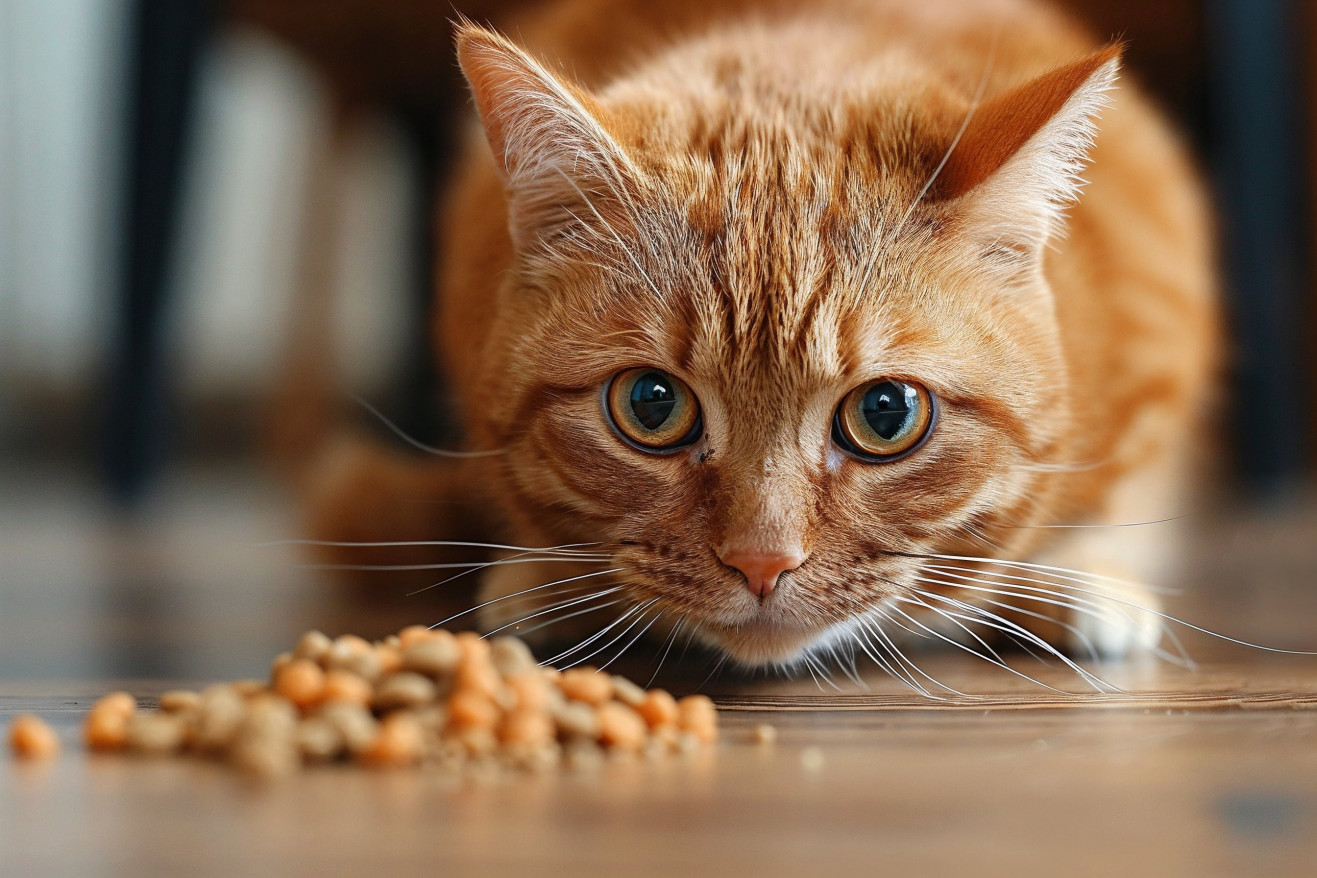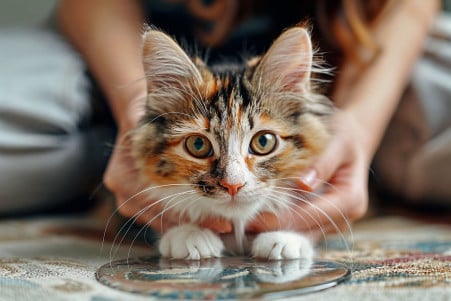Why Is My Cat Throwing Up Undigested Food but Acting Normal?
4 February 2024

If your cat is throwing up undigested food but is otherwise acting fine and healthy, you may be wondering what’s going on. In some cases, eating too quickly or dietary sensitivities can lead to vomiting undigested food in an otherwise healthy cat.
While this is normal if it happens occasionally, if it happens frequently, there may be an underlying issue that requires a trip to the vet. To help prevent this issue, make sure you’re feeding your cat smaller meals and using slow-feeders.
The information below is based on our general knowledge of the topic and the following sources:
In the sections below, we will review insights from veterinarians and studies that have been published in peer-reviewed journals. This will help us better understand the digestive, dietary, and psychological reasons that may lead to this behavior. This knowledge will help you better understand why your cat may be vomiting undigested food while otherwise acting normally and help you better address and possibly avoid this issue in the future.
Why is my cat throwing up undigested food but acting normal?
Understanding the Difference: Cat Vomiting vs. Regurgitation
It is important to know the difference between vomiting and regurgitation in cats to better understand and treat their health issues. Vomiting is an active process where a cat will often show signs of restlessness or anxiety before they throw up a mixture of digested and undigested food, water, and bile.
Vomiting is also forceful and involves retching and abdominal heaving. PetMD notes that cats can also show signs of distress before vomiting, like pacing and swallowing repeatedly.
On the other hand, regurgitation is a passive process that happens soon after a cat eats and only involves undigested food. Petco explains that regurgitated food will also be less digested and won’t contain bile.
Knowing whether a cat is vomiting or regurgitating can help you understand what might be going on with their health. While regurgitation can be a sign of esophageal problems or eating too quickly, vomiting can be a sign of more serious health issues.
To make sure you can help your cat, make sure you know the signs and symptoms of both and pay close attention to your cat’s behavior. If you have any concerns, make sure to talk to your vet.
Inside the Mind of a Cat: Stress and Emotional Eating
A cat’s mental health has a profound impact on its eating habits. For example, if a cat is stressed or anxious, it may eat too quickly and then throw up undigested food. This type of emotional eating, as explained by The Catnip Times, is the feline equivalent of humans using food to soothe negative feelings. Cats, like other animals, can eat in response to emotions like boredom and depression.
There are also social factors at play. Cats can experience stress in multi-cat homes and if their feeding stations don’t allow for natural feeding behaviors. The AAFP’s Consensus Statement, as cited in Food Puzzles for Cats, recommends the use of puzzle feeders and multiple feeding stations, both of which can help reduce stress by allowing cats to engage in their natural hunting behaviors.
To help reduce stress and promote healthier eating habits, which can help address these behavioral problems, experts suggest that cat owners enrich their cats’ environments with feeding puzzles. This will help cats feel more secure and satisfied in their feeding habits.
Nutrition and Wellness: How to Help Your Cat’s Digestive System
Diet and feeding habits are the most important factors in preventing a cat from vomiting undigested food. IAMS recommends portion control and feeding schedules to prevent fast eating, which is a common cause of regurgitation. Smaller, more frequent meals and the use of slow-feeders or puzzle feeders, which require cats to “hunt” for their food, can help prevent this by slowing down the eating process and aiding in digestion.
Royal Canin stresses the importance of feeding cats highly digestible proteins and ensuring the right amount of fat in their diet to help reduce the workload on their digestive system. For cats with sensitive stomachs, single protein diets or hydrolyzed proteins, which are broken down to the point where they are less likely to cause an allergic reaction, can be helpful.
It’s also important to consider food allergies and intolerances. If your cat is vomiting undigested food frequently, it may be helpful to consult with a vet to go over their diet, as food allergies can be a cause of this behavior.
By adjusting feeding habits and keeping a close eye on what your cat is eating, you can help your cat stay healthy and avoid vomiting due to dietary issues.
While these things can help make a cat’s digestive system more efficient, it’s also important to make sure that you’re keeping an eye out for any ongoing problems that could be a sign of a larger issue.
Getting to the Bottom of It: Medical Reasons for Vomiting
While the occasional episode of vomiting in cats is normal, it’s important to understand the medical reasons that may cause your cat to vomit.
Gastrointestinal diseases, including inflammatory bowel disease (IBD), are the most common reason for cats to vomit undigested food while otherwise acting normal. According to the Cornell University College of Veterinary Medicine, IBD in cats is defined as chronic enteritis and colitis that disrupts the normal digestion and absorption of food, leading to symptoms like vomiting, weight loss, and diarrhea.
Metabolic diseases can also affect your cat’s ability to digest their food. According to the Merck Veterinary Manual, metabolic diseases can change the way the body breaks down nutrients and produces energy, leading to symptoms like vomiting. Metabolic diseases can be caused by genetic or acquired factors and are often serious, requiring a quick and accurate diagnosis.
If your cat is vomiting frequently, has a decreased appetite, or is losing weight, it’s important to take them to the vet. Early diagnosis and treatment of medical conditions are important for successful management. Catching these conditions early can help improve the prognosis and often make it easier to manage symptoms, ensuring your cat’s quality of life.
Preventative Measures for Feline Vomiting
Environmental management can go a long way in preventing stress-induced vomiting. The American Association of Feline Practitioners recommends that you create separate feeding stations to avoid competition and stress in multi-cat homes. This will help cats feel safe while they eat and may prevent them from overeating due to stress, as a study in PMC found.
In terms of diet, slow, gradual changes and frequent, small meals can help prevent vomiting by more closely mimicking a cat’s natural eating habits. Texas A&M College of Veterinary Medicine & Biomedical Sciences also suggests using puzzle feeders or slow feeder bowls to slow down eating, which can help prevent regurgitation.
Regular health monitoring is also important, especially if your cat is prone to vomiting. PetCareRx explains that if your cat is vomiting regularly, it’s important to take them to the vet for a checkup to rule out more serious health issues.
As a pet parent, you are the first line of defense in monitoring your cat’s health and well-being. Watching for changes in your cat’s behavior or appetite is important for their health and can help prevent more serious health issues down the line.
Takeaways for Better Cat Health: A Recap
Throughout our investigation of why cats vomit undigested food but are otherwise fine, we made sure to distinguish between vomiting and regurgitation, and we noted that while the occasional vomit is normal, frequent vomiting can be a sign of a serious health issue. We looked at the psychological factors that can impact a cat’s eating habits, including stress and anxiety, and how environmental enrichment can help improve these behaviors.
We also examined the role of diet and feeding in a cat’s digestive health, and we found that slow-feeders and other feeding techniques can be helpful. Finally, we looked at a number of medical issues that can cause vomiting and emphasized the importance of seeking veterinary care to ensure early diagnosis and treatment.
In the end, it’s clear that paying close attention to a cat’s diet, environment, and general behavior is essential. By recognizing and responding to these issues, cat parents can help make sure their feline friends are healthy and happy and maintain the strong bond they share.


